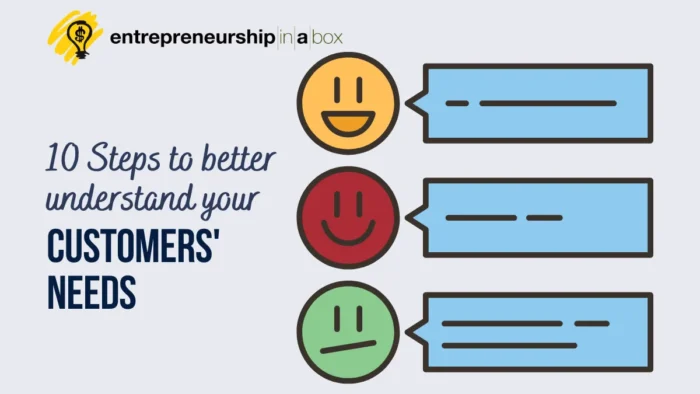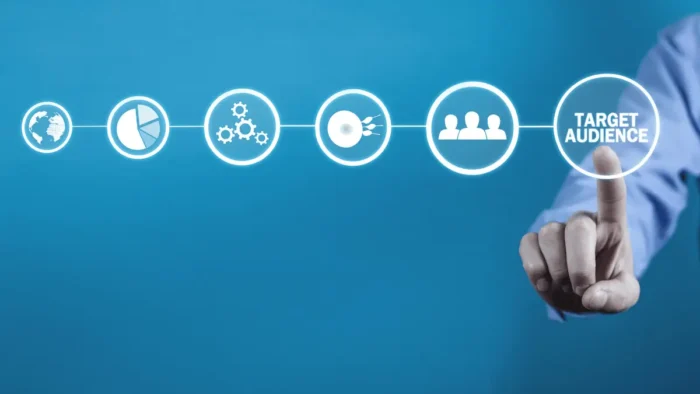As an entrepreneur, you should understand your customer needs as your priority. Businesses that don’t do this quickly fail as an entity.
If you want your business to succeed, you need to work on satisfying real customers’ needs. You must know that you are not selling your products or services. You provide solutions to help them do the job they want to do.
In this article, I want to cover a systematic step-by-step approach for you to understand your customer needs better. Also, at the end of this article, there is a checklist with all the steps and questions you can ask your customers for interviews or surveys to achieve the expected results.
What are Customer Needs?
Customer needs are the functional and emotional aspects your product or service must fulfill for them. They form the foundation for all your business decisions, influencing everything from your product’s design and packaging to your product’s features.

Functional needs are the concrete attributes and capabilities your product or service provides; they are the “must-haves” for it to be considered suitable by the customer. For example, a functional need in a smartphone might be a long battery life, which allows users to go about their day without frequent recharging. This could translate to service reliability, such as a package delivery service guaranteeing on-time delivery.
On the other side are emotional needs, which are a bit more complex. Customers seek these psychological benefits when they purchase a product or service. They are about how a product or service makes a customer feel. For example, buying a luxury car isn’t just about transportation; it’s about the prestige and status it conveys or the sense of security and peace of mind that comes from driving a vehicle known for its safety features. Emotional needs simply connect to customers’ desire for comfort, enjoyment, or confidence in their choices.
Why You Must Understand Your Customer Needs
The foundation of a successful business is an intimate knowledge of the customer. Just as a doctor must understand symptoms to diagnose and treat, a business must understand customer needs to provide value and satisfaction. 66% of customers expect companies to understand their unique needs.
Simply, you will always want to sell more products and services to your customers. But you cannot sell what you want to sell to anyone! You can sell something your targeted customers want to purchase and spend money on your solution. Because of that, it is essential to understand your customer needs.
If you don’t understand your customer needs, you risk two negative effects on your business:
- A low quantity of satisfied customers and losing every unsatisfied customer.
- You will invest your time, effort, and money in products that cannot be sold. They will stay on your shelves or in inventory at your warehouse.
- When you identify customer needs, you can meet and satisfy those needs and, in such a way, generate a loyal customer base for your company.
Low Number of Satisfied Customers
If the customers cannot buy something they want, they will become unsatisfied customers who will search for what they need. However, what is more important is that every new customer who will not satisfy their needs with your business will leave. This means that all your investments in marketing to gain new customers will be for nothing.
Let’s see an example related to this. If you have 1000 current customers for a month and your marketing campaign is good, bringing 100 new customers every month. In the table below, you can see what happens in the next three months with the number of customers you have: 30%, 20%, 10%, and 0% of customers with unsatisfied needs, respectively. See the results in the table:
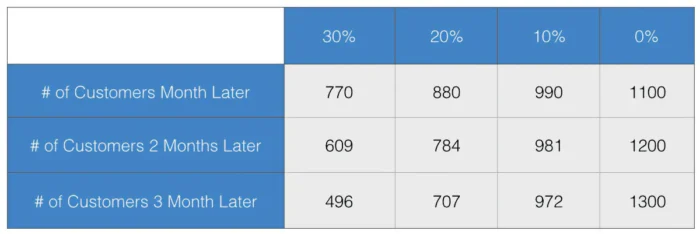
As you can see, with 30%, 20%, and 10% unsatisfied customers, you will continually lose customers, which is the negative butterfly effect. This means you will constantly lose your business’s potential energy in marketing and attracting current customers. Every improvement from 30% to 10% will give you a dramatic increase in that energy.
With 0% of unsatisfied customers, you will have a positive butterfly effect. (Read in Business Butterfly Effect – The Basics for more about positive and negative butterfly effects.) In this case, you will use the business potential energy in your marketing activities and also in your current customers. You can transform that energy into better income and profit for your small business.
Related: Increase Your Brand Potential: How to Measure and Strategies
Losing Money Because of a Low Level of Understanding Your Customer Needs
✋ Warning
Do you want more customers for your business? Learn about six things your customer wants to hear from you.
With the second negative effect, you will lose the potential energy your business stores in your cash and the products you sell to your customers.
First, your cash has a very big potential energy for your business. Without cash, you cannot finance basic business operations. Another thing is that your cash with great business potential energy will be stored in the products that you cannot sell without strong business potential energy.
Meeting Customer Needs Will Help You Generate Loyal Customers for Your Business
Meeting and exceeding customer needs is not just a nice-to-have; it’s a strategic imperative that sits at the heart of long-term business success. Building this loyal customer base will pay off in lasting relationships and a strong, reputable brand.
And like a relationship, the more you understand and respond to your partner’s needs, the more fulfilling the relationship becomes. A satisfied customer is a loyal customer, and a loyal customer is your greatest asset. 89% of successful businesses say anticipating customer needs and providing assistive experiences along the buyer journey is critical to growth.
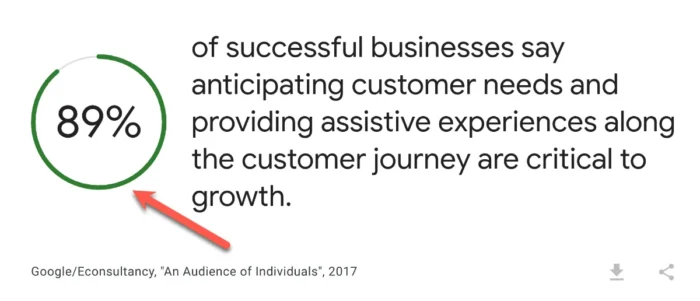
Here is how you will build loyal customers for your company by understanding and meeting customer needs.
- Positive Word-of-mouth: Customers are more likely to share their positive experiences with others when they feel their needs are met. Word-of-mouth can be a powerful, organic marketing tool, as recommendations from friends and family are often trusted more than advertising.
- Repeat business: Customers who find that a company consistently meets their needs are less likely to seek alternatives. This repeat business is more cost-effective than acquiring new customers and contributes to a stable revenue stream.
- Competitive edge: In a crowded market, the ability to meet customer needs effectively differentiates a business from its competitors. Consumers will gravitate towards a company that stands out by providing exceptional value and customer service.
- Improved customer insights: Engaging with customers to understand and fulfill their needs provides you with valuable insights. This information can drive innovation, helping your business to stay ahead of trends and customer expectations.
- Increased Customer Lifetime Value (CLV): Customers who remain loyal over time are more valuable and are more likely to purchase additional products or services. In such a way, they can contribute significantly to your company’s profitability in the long run.
Kano Model: Different Types of Customer Needs
The Kano Model is a tool product developers and marketers use to analyze and categorize customer preferences and expectations. Developed in 1984 by Professor Noriaki Kano, a quality management professor at Tokyo University of Science, it is a sophisticated way to view customer needs, dividing them into several categories:
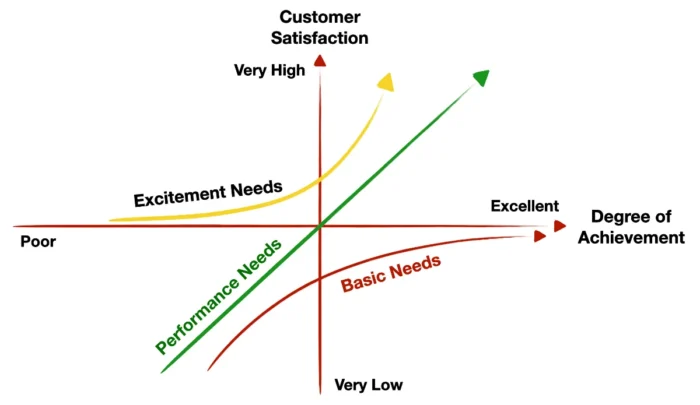
- Basic Needs (Must-be Quality): A customer expects these essential attributes by default. If these needs are not met, customer dissatisfaction is unavoidable. For example, in the smartphone context, a customer expects the phone to be used to make calls without failures. Failure to meet these basic requirements results in negative impressions about the product.
- Performance Needs (One-dimensional Quality): These needs are directly correlated to performance factors, where increased performance leads to increased satisfaction and vice versa. Using the smartphone example again, better battery life might increase customer satisfaction, while poorer battery life decreases satisfaction.
- Excitement Needs (Attractive Quality): These are the features that customers do not necessarily expect but, when provided, result in high customer satisfaction levels.
But, there are additional needs that will not add value in satisfying customer needs:
- Indifferent Needs: These are attributes to which customers are indifferent. Whether these features are present or not, they do not significantly impact customer satisfaction. For example, including a specific default ringtone might not affect a user’s satisfaction with their smartphone.
- Reverse Needs: In certain situations, customers may respond negatively to features they did not want or need, resulting in dissatisfaction. For example, complex additional settings on a basic appliance may disappoint users who prefer simplicity.
By categorizing customer needs using the Kano Model, you can prioritize feature development, focus on what truly matters to the customer, and allocate resources wisely to maximize satisfaction. The beauty of this model is in its recognition that not all customer needs are created equal, and satisfaction can be achieved through a complex balance of meeting basic requirements while also offering delightful surprises that resonate with the customer on an emotional level.
How Can You Better Understand Your Customer Needs?
1. Conduct market research
You should analyze your market to understand your target audience better and identify customer needs.
You may learn more about what your target audience likes, dislikes, habits, and problems by conducting surveys, focus groups, customer interviews, and even using social media.
- Define your customers. Analyze who your customers are, what, why, when, and where they’re buying specific products to target a specific market niche effectively. In this way, you will identify your target market and customers with the right purchase intent to respond to their specific requirements.
- Use surveys for customer feedback. Use surveys to learn more about customers’ experience with your business. They can be online on your website or blog and offline in your store or other places. Using surveys, you can mix current experiences with expectations from potential customers. Use questions about your customers’ demographics, priorities, and pains. To get more personalized information, use an open-ended question.
- Interviews. Interviews are more personalized ways to get information about your customer needs. You can interview your current customers for feedback about your products or services. The interview must include questions about their needs and earlier experience with your products and services.
- Observe how your customers use your products and services. You need to observe how your customers use your products and services. Observation is more costly and time-consuming but still will bring better results than other methods. With surveys and interviews, your customers know about the process, and there is a possibility that they will not give you the most honest response.
Related: A Complete Guide to Market Research
2. Create buyer personas
Buyer personas are imaginary models of your ideal customers based on the research you have made in the previous step to understand your customers needs better. Here are the steps to create buyer personas:
- Identify common characteristics. When you look at the data you have collected about your customers in the previous step, try to find common characteristics like demographics, goals and challenges, motivations, and buying behaviors among your customers.
- Start to develop buyer personas. Now, you can start developing your buyer personas. Remember that each buyer persona should have a name, photo, and detailed information about their goals, challenges, motivations, and buying behaviors.
- Test your newly developed buyer personas: You must test and validate them to confirm that they accurately express their real needs, motivations, and behavior. You can use surveys and interviews to check if they really represent their needs, but it is better to conduct A/B testing of your marketing campaigns. You can easily see whether your personas drive better results using A/B testing with different messages based on already-developed personas.
- Use your buyer personas. Use buyer personas for marketing and sales strategies, product development, and customer service steps. This includes how you can contact your customers with targeted messaging.
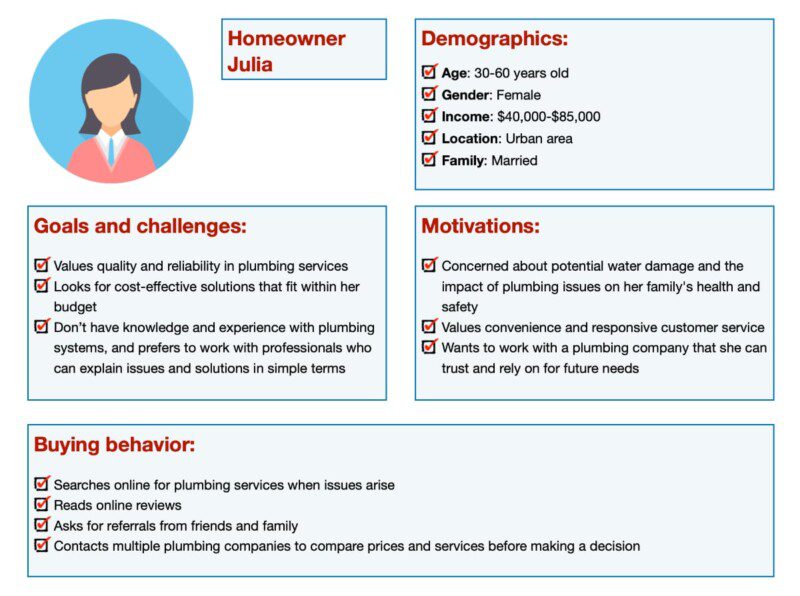
✋ Warning
Follow these 11 steps to create buyer personas to target the right customers.
3. Conduct a Competitive Analysis
Knowing more about your competitors can help you understand what they offer and how they satisfy their customers’ needs. This can help you identify areas to improve or differentiate yourself from them.
Here are some steps you can take to conduct a competitive analysis:
- Who are your competitors? Start with correctly identifying your top competitors in the market.
- Collect data about your competitors. You must collect data about your competitors, and you can use these 22 questions to answer. Explore their website and social media profiles. You want to collect data about the following:
- Competitor’s products and services and features and benefits they offer to their customers;
- Competitors’ marketing efforts and specifically the pain points they are targeting with their marketing.
- Competitors’ pricing strategies they are using with their offerings.
- Customer reviews and testimonials for competitors’ products and services to learn what they are doing well and where they are not so good.
- Competitive benchmarking. When you get all the data, visualize them using benchmarking that will tell you where they are better than you and where you need to improve something.
✋ Warning
You can follow these 13 steps if you want to beat your competitors.
4. Create a customer journey map
A customer journey map can help you to improve your customer experience. Map out the typical customer journey from the first interaction to the end of the customer lifecycle. This will help you identify key touchpoints and moments of truth where you can improve the customer experience.
- Develop your sales funnel to identify the stages of the customer journey. First, you must have developed all the sales funnel stages that a customer goes through when interacting with your small business. These stages will be all the stages inside your journey map.
✋ Warning
You can follow this ultimate guide to build your sales funnel stages and understand the anatomy of your sales process.
- Identify all possible customer pain points you want to target. This step will require you to build a customer pain map. For each stage, you want to identify possible pains that the customer might be feeling. You can see an example in the image below.
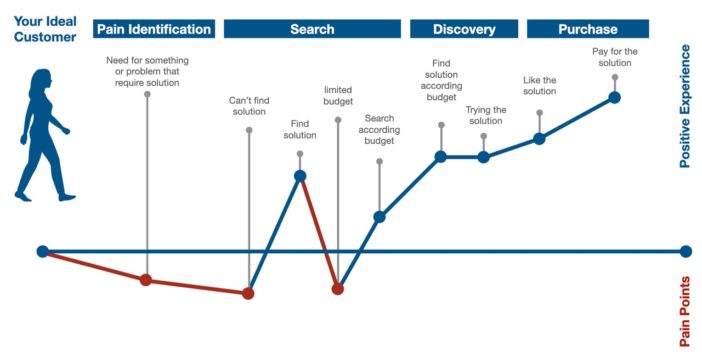
- Create the journey map: Create a visual representation of the journey map, including each stage and touchpoint, as well as the emotions customers might feel at each step. This can be a simple flowchart or a more detailed infographic.
5. Define the kind of problems that your customers face.
You can no longer base your decisions on assumptions because customers’ needs, demands, and wishes constantly change in today’s rapidly changing world. So, you must work to identify the appropriate type of problem for every customer segment.
When your product solves a problem that costs customers sleep, revenue, or profits, things are definitely looking up.
Generally, there are four types of problems that your customers can have:
- Latent problem. Customers who have a problem but are unaware of it are now considered to have a latent problem. Because she is still unaware that he has a problem, even if you offer a great solution, she will not buy the product.
- Passive problem. A passive problem is when customers know about the problem but still aren’t motivated or aware of the opportunity to change. Again, these potential customers will require different offerings and different marketing approaches if you want to motivate them to be aware and solve the problem.
- Active (or urgent) problem. This problem is related to customers who recognize a problem and search for a solution but do not take action to solve the problem.
- Vision. This kind of problem arises when customers know they have a problem and have a strategy for dealing with it. They even try developing their own solution but are ready to pay more for a better one.
Now, you will need to develop a “problem recognition scale” with these four types of problems for each important type of customer.
6. Analyse your customer with the Empathy Map for identifying customer needs.
A great tool that can help you identify real customers’ needs is the Empathy Map, a tool developed by the visual thinking company XPLANE. This tool helps you go beyond a customer’s demographic characteristics and better understand the environment, behavior, concerns, and aspirations.
You must respond to six questions using the Empathy Map:
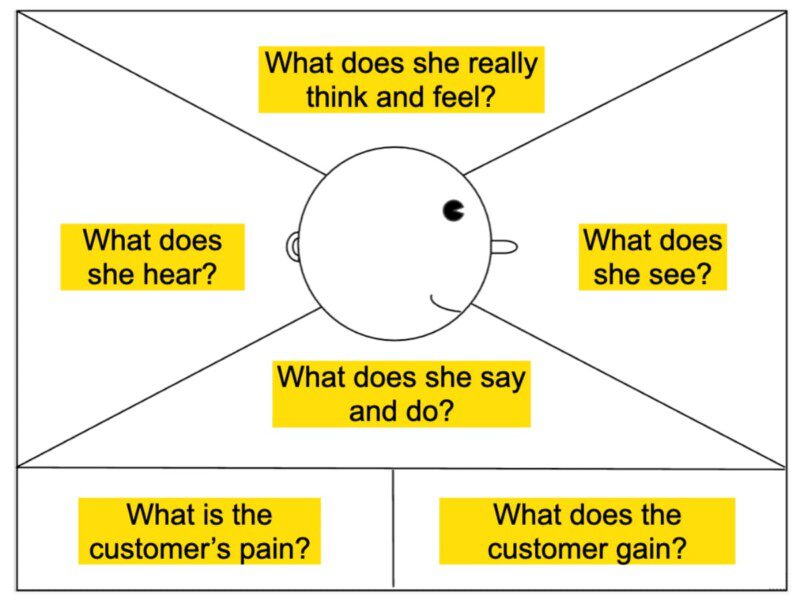
- The first question is, what does the potential customer see? Here, you need to describe what the customer sees in her environment.
- The second question is, what does she hear? Answering this question, you need to describe how the environment influences the customer.
- The third question is, what does she really think and feel? At this stage, you must try to sketch out what goes on in your customer’s mind.
- The fourth question is, what does she say and do? At this stage, you need to imagine what the customer might say or how she might behave in public.
- The fifth question is, what are the customer’s pains? You need to think about the biggest frustrations, obstacles between current and wanted situations and risks she fears taking.
- And the last or sixth question is, what does the customer gain? Think about what they really want or need to achieve, what success is for the customer, and how they want to achieve their goals.
7. Ask your sales team about your customers
Because your sales team is in direct contact with your customers, they can have enough information about them and what they want. Here are some steps you need to take here:
- Encourage active listening from your salespersons. Your salespersons must be active listeners when they interact with your customers. Ensure that they always ask open-ended questions to find their hidden needs, pain points, and challenges.
- CRM. In your CRM, they must record their daily interactions with the customers. So, they can record if some customer asks for something you don’t have, and after that, you will analyze if bringing that type of product or service is possible.
Related: The Team Effectiveness and Different Roles in Teams That Win
8. Customer feedback
Customer feedback is important for understanding their real needs. This data comes directly from your customers.
- Ensure that you collect and analyze customer reviews. Using customer reviews will help you identify what is good and bad for customers working with your business. You can use platforms for reviews, such as Yelp or Google Reviews, and encourage customers to leave a review. They are great sources of information to track their real needs.
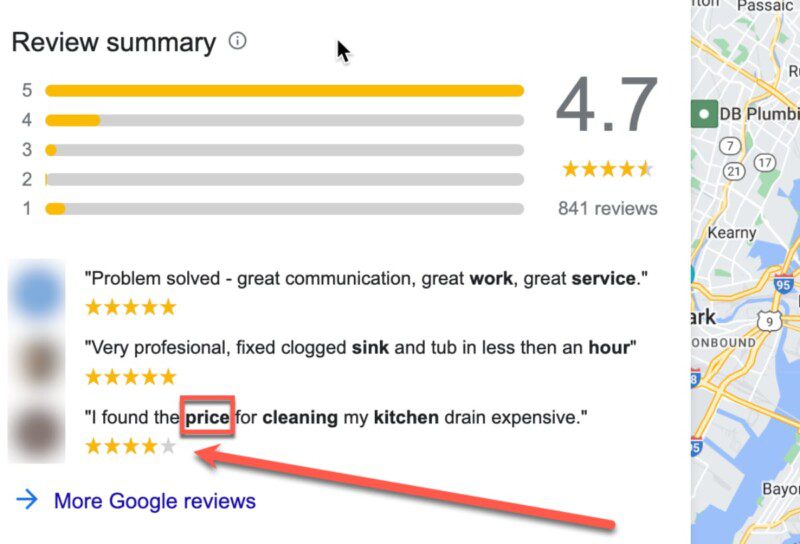
- Customer service. Also, customer service, like support requests, is a great source of information when you want to understand your customers’ needs better.
- Use social networks to understand customers’ needs. You need to listen to your customers through social networks to learn about their experience and expectations working with your business.
Also, look for common patterns and themes that can help you identify the areas that need improvement or changes.
9. Market and industry news and trends
To better understand your customers’ needs, you must monitor and follow the market and industry news.
Read as many magazines as possible that provide articles on subjects related to your market and industry. You can collect many different kinds of data about what is happening outside of your organization and use it to guide your decisions.
Use these two steps to analyze market and industry trends for a better understanding of the needs of your customers:
- Business reports. You should first list any important market or industry reports, trade magazines, and other media sources that are crucial to your business. Additionally, you must stay current on all of the news and developments in your market or industry.
- Follow trends. Nowadays, many people research products online before purchasing them to see what’s available and to learn about other people’s experiences with those products and services. You may examine what is trending right now and the phrases that real people are actually searching for using Google Trends and social media trends.
10. Use other online data sources.
Today, everyone shares their own experience with a specific company. So, positive and negative discussions can help you identify potential customers’ needs.
- Blog comments. Your blog posts may receive various comments if you regularly add new content to a business blog. Don’t ignore the bad comments. Respond that you’ll work to change that impression and seek possible solutions.
- Explore blogs in your industry and leave comments on them. Choose a few blogs in your industry, read the posts, and add insightful comments. The needs of various people with different problems can also be discovered in the comments area. You can also provide solutions to those problems and invite them to your business blog, where they can read about your business.
- Locate top industry-related online forums. Start by selecting the best online forums related to your industry. So, search Google for the following: forum: “keywords or phrases.” You will get possible forums with the keywords you’re interested in. Open them one by one and investigate different discussion boards. Now, you can create a list of all the regularly updated discussion forums to keep up with the latest updates.
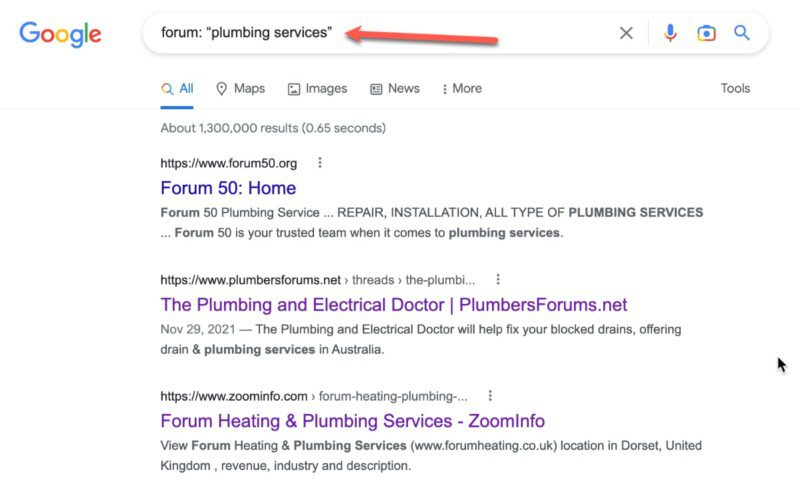
- Good and bad things. You need to search the forum you have located in the previous step for potential positive and negative aspects regarding people’s experience with some product, service, or company. Use terms for expressing happiness or complaints regarding their experience with some company. Customers, for example, seem to appreciate the plumber’s response speed and professionalism, according to the screenshot below.
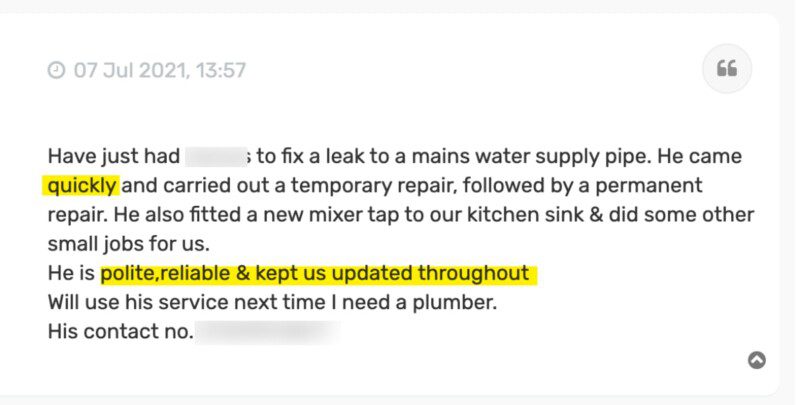
How to Conduct Customer Need Analysis?
Here’s how to conduct a thorough customer need analysis.
1. Survey Customers
Using surveys for identifying customer needs, when constructed thoughtfully, can produce incredibly rich data. They allow you to ask specific questions about needs, desires, and pain points. The key here is to keep surveys short and open-ended questions to encourage genuine responses.
Addressing customer needs with surveys will require using open-ended questions, and you will need to conduct qualitative research. For example, different customers surveyed will define excellent customer service differently.
Here is one example I have made for one company working as their consultant to find disappointments of their clients (bad customer experience) after conducting a qualitative survey:
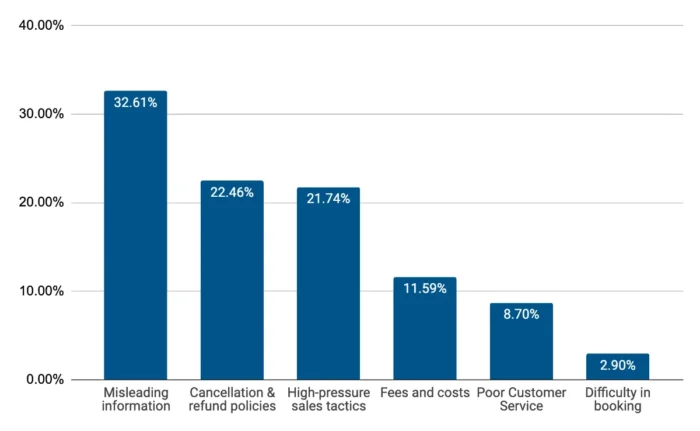
2. Social Media Listening
Social media platforms are treasuries of unasked customer feedback. By tuning into what your customers say online, you can catch invaluable glimpses into their satisfaction, complaints, and suggestions without asking directly.
Social listening today is a strategic approach to monitoring digital conversations to understand what consumers are saying about a brand, industry, or specific product. It involves tracking social media channels for mentions, relevant hashtags, and discussions. You can capture real-time feedback and emerging trends that identify customer needs and sentiments using this.
You can use tools like Hootsuite, Sprout Social, and Mention to effectuate social listening. Also, you can use nVivo to extract and conduct a qualitative analysis of the extracted data to analyze sentiment and customer needs like requirements, wants, and desires.
For example, I have worked with a cosmetics company, and we have used social listening. After extracting data and conducting qualitative research, we discover a growing demand for environmentally friendly packaging.
3. Means-End Approach to Customer Needs Analysis
This approach connects the products’ features with the benefits that meet customer needs. It’s about understanding the why behind the what. A means-end chain can be a powerful tool for discovering customer needs in relation to their deeper motivations.
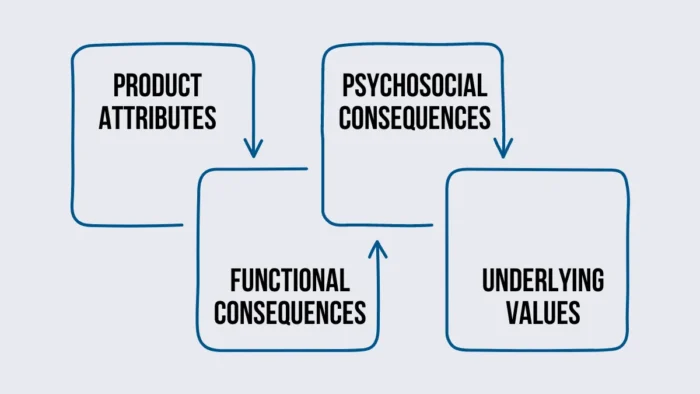
Follow these steps to conduct this analysis:
1. Identify Product Features and Attributes
Start by listing the features and attributes of your product. These are the basic characteristics and tangible features, such as size, color, or technology used.
2. Determine Functional and Psychosocial Consequences
Consider the direct consequences of using the product. What are the practical outcomes and uses that result from these attributes? This may involve an increase in efficiency, convenience, or cost-effectiveness.
Also, you must determine psychosocial consequences for customers that come from their using of your product. Does it provide a sense of belonging, boost self-esteem, or offer peace of mind?
3. Show Values
Link these consequences to the consumer’s personal values. What is the ultimate value that your product provides to the customer? Is it improving the quality of life, fulfilling specific aspirations, or aligning with their self-image?
4. Conduct Laddering Interviews
Use interview laddering techniques to investigate each customer’s reasons behind their decisions. Ask “why” they appreciate specific attributes to reveal underlying values like attitudes, feelings and emotions about a specific attribute.
5. Analyze and Interpret Data
Synthesize the interview data to identify common themes and values that resonate with your customer. This will help you to construct a means-end chain for your product.
4. Customer Feedback
Feedback is not just a passive collection of opinions but an active engagement with your customer base. It should be pursued after, carefully examined, and, where appropriate, integrated into your business strategies.
How to Meet Customer Needs?
Understanding customer needs is only half the battle; the other half is fulfilling and meeting them. Over 50% of customers will switch to a competitor after a single unsatisfactory customer experience. This statistic underscores the importance of consistently meeting customer needs and expectations. Here are some things you need to consider to meet customer needs.
Follow these steps to conduct this analysis:
1. Identify Product Features and Attributes
Start by listing the features and attributes of your product. These are the basic characteristics and tangible features, such as size, color, or technology used.
2. Determine Functional and Psychosocial Consequences
Consider the direct consequences of using the product. What are the practical outcomes and uses that result from these attributes? This may involve an increase in efficiency, convenience, or cost-effectiveness.
Also, you must determine the psychosocial consequences for customers that come from their using of your product. Does it provide a sense of belonging, boost self-esteem, or offer peace of mind?
3. Show Values
Link these consequences to the consumer’s personal values. What is the ultimate value that your product provides to the customer? Is it improving the quality of life, fulfilling specific aspirations, or aligning with their self-image?
4. Conduct Laddering Interviews
Use interview laddering techniques to investigate each customer’s reasons behind their decisions. Ask “why” they appreciate specific attributes to reveal underlying values like attitudes, feelings, and emotions about a specific attribute.
5. Analyze and Interpret Data
Synthesize the interview data to identify common themes and values that resonate with your customer. This will help you to construct a means-end chain for your product.
4. Customer Feedback
Feedback is not just a passive collection of opinions but an active engagement with your customer base. It should be pursued after, carefully examined, and, where appropriate, integrated into your business strategies.
How to Meet Customer Needs?
Understanding customer needs is only half the battle; the other half is fulfilling and meeting them. Over 50% of customers will switch to a competitor after a single unsatisfactory customer experience. This statistic underscores the importance of consistently meeting customer needs and expectations. Here are some things you need to consider to meet customer needs.
Innovation and adaption
Use your understanding of customer needs to innovate continuously. Products and services should evolve with changing customer needs and expectations.
If you want to meet customer needs through innovation, use your customer data to develop features that they will like. So, your product development process will need to be cyclical, continuously working on existing product improvement and developing new innovative products that will use customer data to meet their needs.
Provide Excellent Customer Service
Building customer-centric companies with exceptional customer service is integral to meeting customer needs.
A global survey in 2022 found that 90% of marketing professionals across 35 countries were using artificial intelligence (AI) tools to automate customer interactions, compared to 88 percent in 2021. It is the lifeline that can turn the tide in your favor during disagreements and can help in upselling and cross-selling. So, remember you don’t need good customer service, but exceptional customer service.
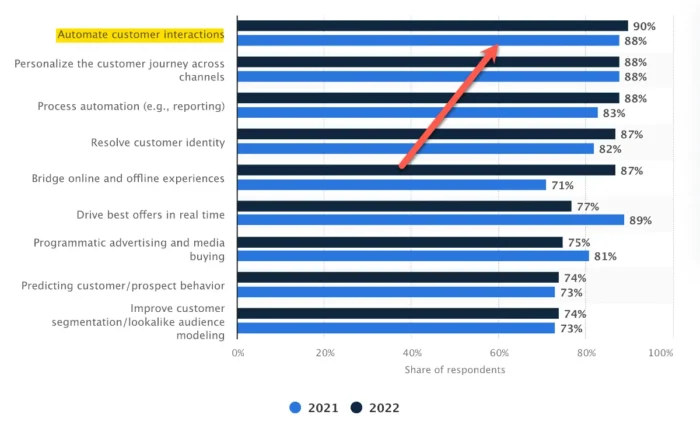
Related: How to Turn Bad Customer Experience Into Extraordinary in Just 6 Simple Steps
You can effectively meet customer needs by combining communication strategy and customer service structure. This means having an organized framework that defines how customer interactions are managed. This structure typically contains the roles, teams, protocols, technologies, and strategies in place to deliver quality service. A well-defined customer service structure should align with your company’s larger customer experience goals, ensuring that every customer interaction is consistent, efficient, and effective. It also includes clear escalation paths for resolving issues and metrics for evaluating performance and customer satisfaction.
Related: 7 Amazing Communication Tools You Can Use With Clients
Personalization
The era of personalization is not just a trend but a fundamental necessity today. Personalization surpasses generic interaction by tailoring to each customer’s unique needs and preferences.
While 85% of brands believe they offer a personalized customer experience, only 60% of consumers agree. This discrepancy suggests that many businesses may not fully understand or meet their customers’ expectations for personalized service.
This approach fosters a deeper connection with buyers, making them feel genuinely valued and understood by the brands they engage with.
Transparency
Be open about what your product or service offers. Present the features that fulfill customer needs in the most authentic and compelling way possible.
Transparency in meeting customer needs is not only about clear communication but also about fostering trust. When companies are transparent, they allow customers to see the internal workings of their offerings – the composition of products, the pricing models, and even the company’s values and operational practices.
According to a Label Insight study, 94% of consumers are likely to be loyal to a brand that offers complete transparency. This can include everything from product development processes to pricing structures.
Wrap up
In conclusion, a business’s success depends on understanding its customers’ needs. You can learn much about your customers’ preferences, problems, and habits by executing the ten steps in this article. With this insight, you can adjust your offers to suit their needs better and exceed their expectations. Always remember that asking for feedback from your clients and listening to them is a never-ending process that demands commitment and devotion. But by doing this, you may improve your customer relationships and achieve long-term business growth.
Download the Checklist With All 10 Steps and Questions to Ask Customers
Start implementing these steps one by one. Use the questions you can ask your customers for interviews or surveys to achieve the expected results.

